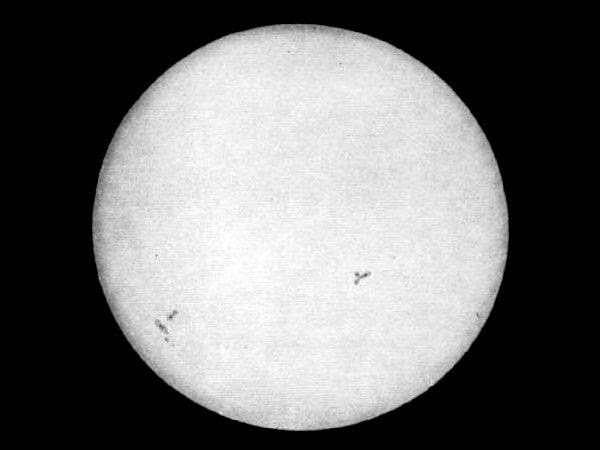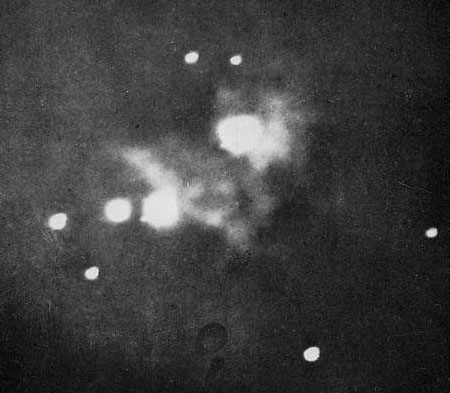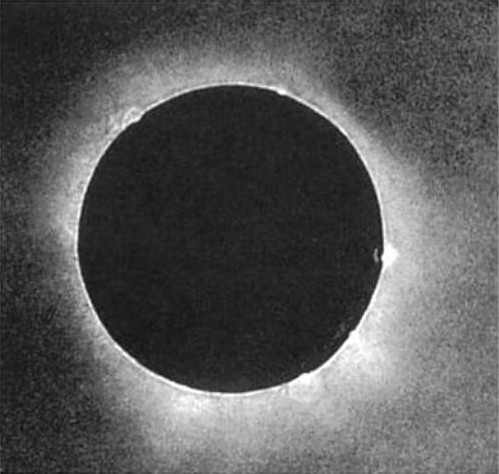
The first photograph of the Sun was made by Léon Foucault and Hippolyte Fizeau on 2 April 1845 in Paris, France.
On April 2, 1845, Armand Hippolyte Louis Fizeau and Jean Bernard Léon Foucault manage to make the very first photography of the Sun. Thereby, they both initiated astronomical photography.
“To contribute usefully to the advance of science, one must sometimes not disdain from undertaking simple verifications.”
– Léon Foucault (in The Life and Science of Léon Foucault : The Man Who Proved the Earth Rotates, 2003)
Before Astronomical Photography
From a previous blog post you may remember Léon Foucault’s Pendulum.[4] The instrument was used to proof Earth’s rotation in the 1850s and counts to one of Foucault’s biggest scientific achievements. But let’s start a little bit earlier. Leon Foucault was born on September 18, 1819 as the son of a publisher in Paris. After an education received chiefly at home, he studied medicine, which he abandoned in favor of physics due to a fear of blood.
Meanwhile, astronomical photography started to establish slowly. There were not many experts in the field back then, since the very long exposures needed to capture relatively faint astronomical objects and many technological problems had to be overcome. Completely new telescopes had to be developed that were rigid enough in order to not lose the focus during exposure time. Also the telescopes had to be attached to a rotating mount that would move at a constant rate very accurately. Next to the telescope building itself, the technology of photography needed improvement as well. The daguerreotype was just introduced in 1839 and came into a very widespread use. However, for astronomical photography, the process was too slow and was only able to record very bright objects. Also, the exposure time was very limited using this method due to the wet plate collodion process.
Daguerre’s Invention
Louis Jacques Mandé Daguerre experimented in the field of astronomical photography for quite a while already.[5] The daguerreotype process was invented by him and soon he attempted to photograph the moon. Unfortunately, he failed to guide the telescope accurately during the exposure, wherefore the outcome was only a “fuzzy spot”. The first known successful photograph of the moon was taken by the New York University Professor John William Draper on March 23, 1840, using a 5-inch reflecting telescope and managing a 20-minute-long exposure with the daguerreotype process.[6] He also took the first spectrogram of the sun in 1843.

Henry Draper’s 1880 photograph of the Orion Nebula, the first ever taken.
Foucault and Fizeau
Léon Foucault was highly influenced by Daguerre and his work in his early scientific years and he devoted much of his time to improve Daguerre’s photography techniques. Hippolyte Fizeau was born in 1819 as well and astronomical photography counted to the scientist’s earliest interests, too. Both managed to take the first known photograph of the Sun in 1845 using an improved daguerreotype process. The scientists finally proved that high quality astronomical photography was possible and only six years later the first Solar eclipse was successfully recorded by a daguerreotypist named Berkowski at the Königsberg Observatory. He was advised by it’s director, Dr. August Ludwig Busch. However, a failed attempt to obtain a photograph of a Total Eclipse of the Sun was already made by the Italian physicist, Gian Alessandro Majocchi during an eclipse of the Sun that took place in his home city of Milan, on July 8, 1842. After Foucault, Fizeau and Berkowski, astronomical photography was officially ‘born’ and Vega soon became the first star captured with the daguerreotype process by astronomer William Cranch Bond and daguerreotype photographer and experimenter John Adams Whipple.

The first solar eclipse photograph taken on July 28, 1851 by a daguerrotypist named Berkowski.
When dry plate photography was introduced in the 1870s, scientists finally managed to use astronomical photographs as professional research tools. The English astronomer Sir William Huggins and his wife Margaret Lindsay Huggins were back then the first known scientists to use dry plate photography in their work to record the spectra of astronomical objects. On this day, astronomical photography has evolved as a popular hobby among photographers and amateur astronomers next to its significant role as a research tool for professionals.

Comparison of visible magnesium spectrum with that of Orion nebula by Huggins and Huggins
The Art of Astrophotography – Professor Ian Morison, [10]
References and Further Reading:
- [1] One of the first photos of the Sun
- [2] The History of Astrophotography
- [3] Astrophotography Techniques
- [4] Foucault’s Pendulum, SciHi Blog
- [5] Making Photography Really Operational – Louis Daguerre, SciHi Blog
- [6] John William Draper – Chemist and Photo Pioneer, SciHi Blog
- [7] Jean Bernard Léon Foucault at Wikidata
- [8] Armand Hippolyte Louis Fizeau at Wikidata
- [9] Peter Abrahams: The Early History of Astrophotography
- [10] The Art of Astrophotography – Professor Ian Morison, 2017, Gresham College @ youtube
- [11] Timeline of Optical Physicists via DBpedia and Wikidata





